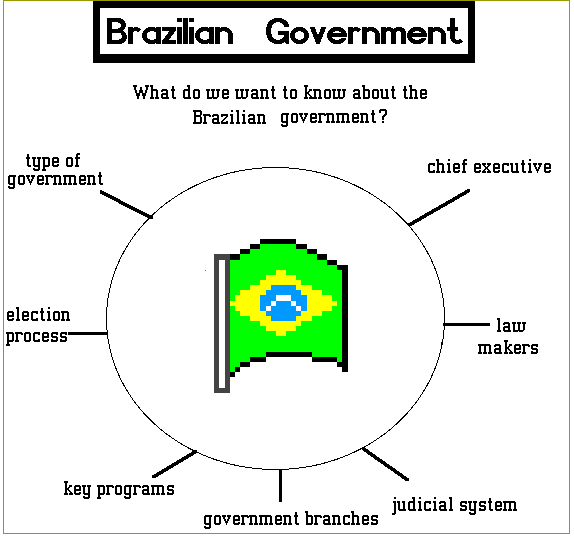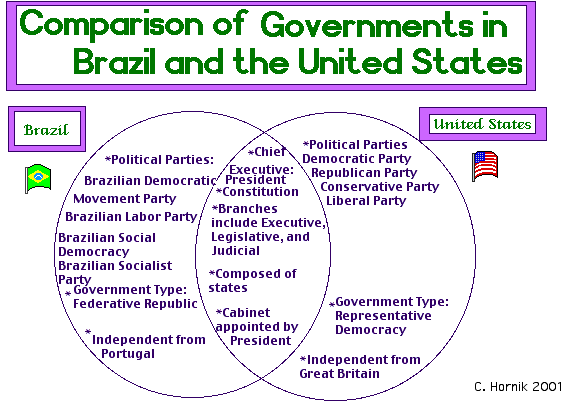|
Image credit: Fossil Energy International: Brazil |
|
P.S. 101 |
|
|
Image credit: Fossil Energy International: Brazil |
1. To understand how the Brazilian Government functions.
2. To develop an appreciation for the way of life of other countries.
3. To compare and contrast the American system of government with that of Brazil.
4. To develop research skills using the Internet.
5. To organize thoughts into a written and oral presentation.
Standards Addressed:
1. Demonstrate an understanding of the variety of governmental structures (military, dictatorship, democracy) in the United States and Latin America.
2. Appreciate the struggles involved in independence movements and changes of governments.
3. Meet in groups.
4. Synthesize written information into a report.
5. Present oral and written reports.
Set Up:
The "Government Cooperative Learning Group" will participate in the activities
listed in this lesson. Roles will include researchers who will find
information online using web sites chosen by the teacher, recorder who
will record the important information found by the researchers (information
may be recorded using a word processing application such as Learning Company's
Student Writing Center or Microsoft Word), illustrators
who will be responsible to find online photos (from web sites that will
be prescreened by the teacher) or create illustrations of the topics researched
by the group using a drawing and painting application such as Kidpix,
reporters,
who share the information with the class both in oral reports and in
written reports, and web designers who will place the textual information
and graphics onto a web site for the class Virtual
Travel Brochure.
Vocabulary:
Dictionary.com may be used to introduce and define the vocabulary words.
| government | dictatorship | monarchy | democracy | constitution | suffrage |
| republic | executive | judicial | legislative | political party |
Materials:
computer with Internet capabilities, word processing application,
drawing and painting application, web authoring application such as Netscape
Navigator or Microsoft FrontPage, printer.
Motivation:
I. Students brainstorm to develop a list of information needed to research about the Brazilian government. Thoughts are listed on a semantic web.
 |
| What are the main branches of government? | executive, judicial and legislative |
| Who is the chief executive? | President Fernando Henrique Cardoso |
| Who makes the laws? | bicameral National Congress or Congresso Nacional consists of the Federal Senate or Senado Federal (81 seats; three members from each state or federal district elected according to the principle of majority to serve eight-year terms; one-third elected after a four year period, two-thirds elected after the next four-year period) and the Chamber of Deputies or Camara dos Deputados (513 seats; members are elected by proportional representation to serve four-year terms) |
| What is the judicial system like? | Supreme Federal Tribunal, 11 judges are appointed for life by the president |
| How are the leaders chosen? | president and vice president elected on the same ticket by popular vote for four-year terms |
| What are the governments key programs? | Real Plan, a package of fiscal reforms, limit elicit drugs, environmental programs to save the Amazon Rain Forest |
| Describe the type of government. | Federative republic, elections are held for government executives and legislators. |
| What is the history of the government? | Brazil had seven constitutions since its independence. Six were republican constitutions; of those, four (including the present one) were democratic. The 1891 Constitution abolished the monarchy and introduced separate state powers. There have so far been six new republican constitutions. On Oct. 5, 1988 the latest constitution was drafted by a National Congress, specially empowered in 1984. |
| What are the Administrative divisions? | 26 states or estados; federal divisions are: Acre, Alagoas, Amapa, Amazonas, Bahia, Ceara, Distrito Federal*, Espirito Santo, Goias, Maranhao, Mato Grosso, Mato Grosso do Sul, Minas Gerais, Para, Paraiba, Parana, Pernambuco, Piaui, Rio de Janeiro, Rio Grande do Norte, Rio Grande do Sul, Rondonia, Roraima, Santa Catarina, Sao Paulo, Sergipe, Tocantins |
Development:
Students log onto the following web sites and use Grolier's Multimedia Encyclopedia (Grolier Interactive, Inc. 1997, licensed by Mindscape, Inc., Novato, Ca.) to answer the questions listed in the database.
1. World Rover at http://worldrover.com/vital/brazil.html
Provides information about Brazil's economy, government, location, environmental concerns, and population.
2. U.S.A. Immigration Software:Brazil Government
http://immigration-usa.com/wfb/brazil_government.html
This site provides information in English and outlines the facts about Brazil's government.
3. Republica Ferderativa do Brasil www.brasil.gov.br
For students who speak Portuguese, this is an excellent resource for all types of information in regard to Brazil's government and economy.
4. Governments on the WWW: Brazil
This site has an English translation of the Portuguese web site about Brazil's government. This is good for getting a list of governmental agencies.
5. http://education.yahoo.com/reference/factbook/br/govern.html
This site provides information regarding Brazil's government including administrative divisions, suffrage, legal system, and branches of government.
6. http://odci.gov/cia/publications/factbook/geos/br.html
At this site you will find information on the type of government, administrative divisions, capital, political parties and branches of government.
7. http://state.gov/www/background_notes/brazil_0700_bgn.html
This The State Department web site contains information about Brazil's government including administrative divisions, suffrage, legal system, and branches of government.
8. http://lex5.k12.sc.us/ces/brazhis.htm
This is Brazil's History Channel and includes information about Brazil's government including administrative divisions, suffrage, legal system, and branches of government.
9. http://uni-wuerzburg.de/law/br__indx.html
This is Yahoo's World Fact Book. The information presented includes Brazil's constitutional background and constitutional reform.
10. http://historychannel.com/
(Enter Brazil Government as key words in the search box). At this site students will find information about the history of Brazil's government.
Summary:
From the information obtained in the research phase of this lesson, oral and written reports will be produced and shared with class. These reports will include pictures and drawings as visual aids.
Evaluation:
Students will be evaluated on their use of the Internet to find information about Brazil's government and synthesize that information to produce oral and written reports. Students presentations will be evaluated on their choice and use of visual aids, and their ability to communicate the information in their reports to the class in their presentation.
Follow Up:
After inserting information found during the research phase of the lesson on the T Chart or database, students can compare and contrast Brazil's government with that of the United States. A Venn diagram may be used as in the sample below:
 |
 Click
here to return to the Table of Contents.
Click
here to return to the Table of Contents.